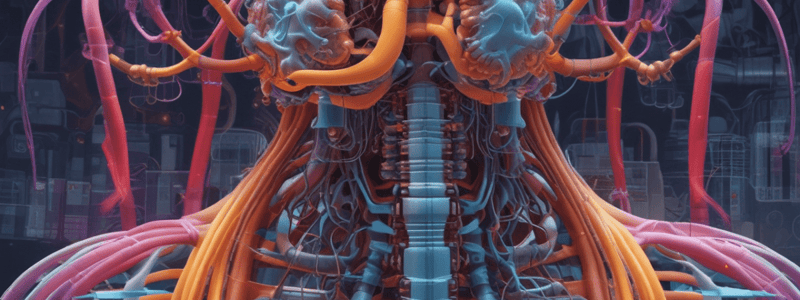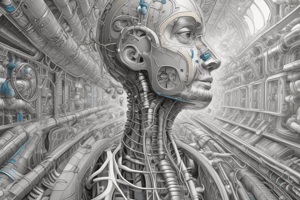Podcast
Questions and Answers
What is the relationship between pressure and volume of a gas according to Boyle's Law?
What is the relationship between pressure and volume of a gas according to Boyle's Law?
- The pressure of a gas is directly proportional to its temperature at a constant volume.
- The pressure of a gas is independent of its volume and temperature.
- The pressure of a gas is directly proportional to its volume at a constant temperature.
- The pressure of a gas is inversely proportional to its volume at a constant temperature. (correct)
What happens to the thoracic volume during inspiration?
What happens to the thoracic volume during inspiration?
- The thoracic volume increases. (correct)
- The thoracic volume decreases.
- The thoracic volume first increases and then decreases.
- The thoracic volume remains constant.
What happens to the pressure inside the lungs during inspiration?
What happens to the pressure inside the lungs during inspiration?
- The pressure inside the lungs decreases and becomes less than atmospheric pressure. (correct)
- The pressure inside the lungs first increases and then decreases.
- The pressure inside the lungs increases and becomes greater than atmospheric pressure.
- The pressure inside the lungs remains constant.
What is the relationship between ventilation and perfusion in the lungs?
What is the relationship between ventilation and perfusion in the lungs?
What is the definition of compliance of the lungs?
What is the definition of compliance of the lungs?
What happens to the thoracic volume during expiration?
What happens to the thoracic volume during expiration?
What happens to the pressure inside the lungs during expiration?
What happens to the pressure inside the lungs during expiration?
What is the main function of the diaphragm during the breathing cycle?
What is the main function of the diaphragm during the breathing cycle?
What is the total compliance of both lungs?
What is the total compliance of both lungs?
What is the purpose of the lung's compliance and elasticity?
What is the purpose of the lung's compliance and elasticity?
What muscles are involved in maximum inspiratory effort?
What muscles are involved in maximum inspiratory effort?
What is the purpose of forced expiration?
What is the purpose of forced expiration?
What is lung compliance?
What is lung compliance?
What is the role of the diaphragm in inspiration?
What is the role of the diaphragm in inspiration?
What is the role of the internal intercostal muscles in expiration?
What is the role of the internal intercostal muscles in expiration?
What is the role of the abdominal wall muscles in expiration?
What is the role of the abdominal wall muscles in expiration?
What is the formula for compliance in the context of lung physiology?
What is the formula for compliance in the context of lung physiology?
What is the reciprocal of compliance known as in lung physiology?
What is the reciprocal of compliance known as in lung physiology?
What property of the lungs is responsible for the tendency to return to their normal position after being inflated?
What property of the lungs is responsible for the tendency to return to their normal position after being inflated?
What factor determines lung elasticity related to elastic fibers and surface tension?
What factor determines lung elasticity related to elastic fibers and surface tension?
What force is primarily responsible for quiet expiration in the lungs?
What force is primarily responsible for quiet expiration in the lungs?
In lung physiology, what is the principle behind why water droplets form spherical shapes?
In lung physiology, what is the principle behind why water droplets form spherical shapes?
What does elastance measure in the context of lung physiology?
What does elastance measure in the context of lung physiology?
What happens when surface tension on the inner surfaces of alveoli attempts to contract in the lungs?
What happens when surface tension on the inner surfaces of alveoli attempts to contract in the lungs?
Which property of lungs allows them to easily expand at a given transpulmonary pressure?
Which property of lungs allows them to easily expand at a given transpulmonary pressure?
What is the normal value of lung compliance in mL/cm H2O?
What is the normal value of lung compliance in mL/cm H2O?
Flashcards are hidden until you start studying
Study Notes
Mechanics of Ventilation
- Ventilation is the movement of air into the lungs, governed by Boyle's Law, which states that at a constant temperature, the pressure of a given quantity of gas is inversely proportional to its volume.
- Inspiration (inhalation) occurs when the diaphragm contracts and descends, the external intercostal muscles contract, and the chest expands, increasing the thoracic cavity volume and decreasing the pressure inside it.
- As the lung volume increases, the inside pressure (in the alveoli) decreases, becoming less than atmospheric pressure, allowing air to flow into the respiratory passages and into the alveoli.
- Expiration (exhalation) occurs when the diaphragm and external intercostal muscles relax, the chest collapses, and the thoracic volume decreases, increasing the thoracic pressure and causing air to flow out of the lungs into the respiratory passages and to the outside.
Compliance and Elasticity of the Lungs
- The lungs expand and collapse in response to changes in thoracic volume.
- The lung must be able to distend when inflated (compliant) and return to its original size when deflated (elastic).
- Normally, compliance and elasticity are well balanced, allowing the lung to be inflated and deflated with ease.
- Compliance is the ease with which the lungs are inflated, defined as the change in lung volume (∆V) per a given change in the distending pressure (C = ∆V /∆P).
Factors Affecting Lung Compliance and Elasticity
- Lung compliance is opposite of stiffness, with a greater compliance indicating easier expansion of the lungs at a given transpulmonary pressure.
- Normal lung compliance is 200 ml/cm H2O, meaning the lungs expand by 0.2 L for an increase in 1 cm H2O in distending pressure.
- Elasticity is the reciprocal of compliance (Elastance = 1/Compliance) and depends on elastic fibers content and surface tension in the alveoli.
- Surface tension in the alveoli causes an elastic contractile force, attempting to force air out of the alveoli and collapse the lungs.
Maximizing Inspiration and Expiration
- Inspiration can be quiet (using only the diaphragm) or forceful, involving muscles of the back, chest, and neck.
- Maximum inspiratory effort increases the size of the thoracic cavity, allowing maximum expansion of the lungs.
- Expiration can also be forced, involving contraction of internal intercostal muscles and abdominal wall muscles, which helps expel air.
Studying That Suits You
Use AI to generate personalized quizzes and flashcards to suit your learning preferences.




